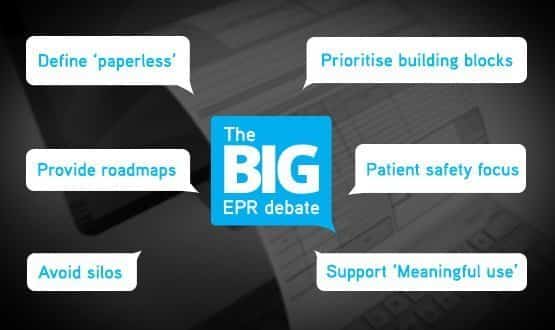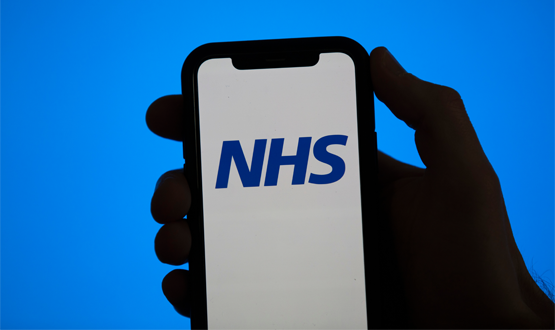The Big EPR Survey: responses
- 16 May 2013

Ten years on from the start of NPfIT the limited availability of clinically rich electronic patient records in hospitals remains the essential missing pre-requisite of a digital ‘paperless’ NHS, say EHI readers.
And as NHS hospital trusts grapple to develop EPRs they are looking for much clearer guidance from the centre, including route maps to inform priorities and strategy.
The survey shows there is a demand for a clear steer from the centre on the critical issue of how to get EPRs into trusts, which have the furthest to go after the decade of the national programme.
In almost 300 responses to The Big EPR Survey, EHI readers indicated that they want NHS England to reiterate the importance of an EPR as the core, organisational record on which other forms of data exchange and secondary usage can be built.
They would like the commissioning board to set out a road map or road maps for EPR for trusts at different stages of digital development. EHI readers also said that they would like to see road maps back with targets and incentives based on ‘meaningful use’ of clinical systems.
The backing for ‘meaningful use’ targets suggests support for focusing on ensuring systems are used to support patient care, rather than whether they have been bought or installed. For complex clinical systems like e-prescribing there can often been a significant gap between the two.
But respondents do not want to see shortcuts adopted in the form of technologies that would simply digitise existing ways of working. “It is important that all data in an EPR is at least searchable, otherwise it is not much better than rummaging through paper,” one wrote.
Define paperless
In January, health secretary Jeremy Hunt told the Policy Exchange think-tank that he wanted to see the NHS become paperless by 2018. He added that NHS England would issue guidance on the first step – getting trusts to use electronic records – in June.
Trusts are supposed to have strategies in place by April. EHI launched The Big EPR Debate last month, because there seems to be a small but significant window of opportunity to influence the plans.
Despite the excitement caused by Hunt’s pledge, neither he nor NHS England have really defined what is meant by paperless or electronic patient records. Some have suggested that the policy is scrambling to catch up with the ‘paperless’ sound bite.
Some respondents were arch in their comments about “paperless”, with one free text comment saying it was a “red herring” and another describing it as a “dangerous pipe dream”, given concerns about cost, usability and confidentiality.
Defining EPRs, however, was a real concern. The legacy of the NHS IT strategies issued in 1992, 1998 and 2000 is a number of phrases – electronic patient record and electronic health record / integrated, detailed and summary care records – that have different meanings for different readers.
No fewer than nine out of ten respondents (90.2%) said the commissioning board should start by defining its terms.
Pinning down EPR
In The Big EPR Debate, EHI is using the term EPR to mean “the core, organisational record on which integrated health and social care records and secondary uses can be built” and this was supported by eight out of ten (79.9%) of survey respondents.
Additionally, almost nine out of ten respondents (88.5%) said such records were a “pre-requisite” for a paperless NHS.
The important implication is that policy makers should not be diverted by other technologies that appear to promise easy gains – "document scanning" and “single use apps” were mentioned in free text responses.
Readers suggested these technologies might have a role alongside the EPR. But they were clear that they should not count as part of an EPR, because they cannot deliver “an exchangeable record.”
Where is the ‘route map’?
Another legacy of the 1990s strategies is the ‘ladders’ or ‘route maps’ to EPR models that recognised that EPR is not a thing, or a system, but a journey. The survey shows that these models continue to have considerable influence and validity.
Given a list of 15 the core systems, the Lego of an EPR, that might build from a basic to a more sophisticated EPR, most respondents ranked them in importance.
Specifically, most readers (85.3%) said that a patient administration system was “core” to an EPR; with free text comments suggesting that “a master patient index, rules engines and an integration engine” might do a similar job, if the trust rethought its business around scheduling workflow.
Following on from a PAS, between five and six out of ten readers picked pathology (59.4%), order communications (58.9%), diagnostic reporting (62.9%) and pharmacy systems (50.9%) as “core” – along with clinical noting (68.3%) and e-prescribing (57.6%).
Five out of ten readers then identified A&E, theatres and maternity systems (47.8%) and more specialist departmental systems (35.7%) as “core.”
Responses suggested that technologies that could be “left for later” included clinical decision support (12.9%), advanced scheduling (9.4%), and patient level information costing systems (20.5%).
Notably these are the most sophisticated elements of a modern EPR, and in the case of clinical decision support, arguably where the greatest clinical benefit is likely to derive.
The terms used and list of systems annoyed some respondents. Free-text comments included arguments that records should be rebuilt around patients, that “the basic EPR is the GP record”, and that “these hackneyed terms blur the fundamental need to support inter-specialism communications."
One comment strongly argued that just using a term “dating from the 1980s or 1990s” was enough to suggest that “cloud, apps etc had not been invented.”
But most respondents argued that the EPR concept remained valid, and the real challenge is “how to get [systems] to work together” and, specifically, how to decide what elements to buy as an integrated system and what elements to interface to.
Multiple routes to EPR
Asked “what is the best route for trusts to achieve EPR”, respondents were quite evenly split between “using one supplier for all elements” / “using one supplier for the key elements and other suppliers for specialist systems” (17.1% and 31.1%) and “use different suppliers as appropriate” (42.8%).
But free text comments stressed the importance of integration. “The more elements come from one supplier, the better the end result will be,” one respondent argued.
Another elaborated that this was because “there is no means for the foreseeable future of interfacing clinical decision support rules between systems.”
Other comments noted that integration engines and individual software licenses are expensive. Yet there was a recognition that “some systems will always need to be interfaced” – including picture archiving and communications systems and very specialist systems.
The issue is where to put the boundary between integration and interfacing. And a number of respondents said this would depend on the trust’s situation and how many legacy systems it had.
Basic contours and destination, please
Respondents to The Big EPR Survey were keen on the idea of NHS England drawing up a road map or road maps to help trusts determine the best way forward.
No fewer than eight out of ten (80.5%) backed this idea, with one free text response saying “I don’t think it should be too prescriptive, but [there should be] guidance with different routes – if you have a lot of legacy investment you need to do X, if you have limited legacy investment then you need to do Y.”
Respondents were more evenly split on whether “the guidance should add targets for reaching different implementation milestones – with 58.8% saying it should, and 41.5% saying not.
There was a similar split on whether there should be incentives for reaching implementation milestones, but far more support for the idea of payments for ‘meaningful use’.
President Barack Obama’s American Recovery and Reinvestment Act of 2009 created a programme with billions of pounds of incentives for hospitals and clinics that could show ‘meaningful use’ of clinical IT; and this has been widely credited with dramatically accelerating the adoption and use of Electronic Medical Records across the US healthcare system.
Some two thirds of survey respondents (63.2%) said meaningful use should be tried in the UK; with 36.8% saying ‘no’ to the idea. The surprise is perhaps less the level of support than the fact that over a third disagreed with the concept of ‘meaningful use’.
In free text responses, readers argued that incentives would encourage progress – “IT can be a Cinderella service and needs support” – and stop progress being confined to one or two areas.
On the other hand, they noted that payments of any kind would require money – and Hunt has said there isn’t any, beyond what trusts can generate through efficiency and quality improvements – and potentially, encourage a tick-box mentality.
“You need a carrot and stick to create real incentives, but not meaningful use – too many rules result in gaming rather than in meaningful activity,” one argued.
Lay off the penalties
One alternative to incentives is, of course, penalties. Earlier in the year, national director of patients and information Tim Kelsey appeared to suggest that NHS England is considering penalties for trusts that don’t get systems in place to deliver the massive data sets that it wants to deliver on its remit of holding the NHS to account for outcomes.
However, survey respondents were clear that if a roadmap and targets were created, trusts should not attract penalties for missing them.
Six out of ten readers (61.8%) said there should not be penalties for missing implementation milestones, and half (52.1%) said there should not be penalties for missing meaningful use milestones.
A number of free text responses warned this would lead to bad behaviour. “The focus becomes skewed to avoiding the penalty, instead of what is trying to be achieved.”
Others said “not qualifying for incentives should be penalty enough” and that it would be more constructive to “find out why they haven’t delivered” and then offer “advice and extra support.”
On the support front, there was support for NHS England to set up an “exemplar” programme to “identify leading trusts and encourage others to follow their example”, with eight out of ten (79.1%) of respondents saying this was a good idea.
Utopia, here we come
Overall, the key message of the survey is that EHI readers want to finally realise the vision of the NHS’ original IT strategies; a connected health service, built on increasingly sophisticated EPR systems, that can exchange structured and so analysable data with each other.
In support of this, they would like NHS England to revisit the EPR models, and to provide roadmaps that not only suggest which systems to prioritise, but where to put the integration and interfacing boundary.
The survey recognised that lots of other things are needed – standards, good infrastructure, the right user devices, clinical involvement, clinical involvement and more clinical involvement.
But as one respondent summed up: “From an acute perspective, there should be a fully integrated core, with minimal legacy specialist systems or best of breed.
“There might be a portal if there is heavy legacy systems investment. However, the road map should reach Utopia eventually, and that is a fully integrated solution, with full interoperability (standards) to join up other EPRs, such as GP, community, mental health, and links to social care.”
The winner of the iPad-mini draw for survey respondents was Glyn Brace, supervisor of midwives at Royal Devon and Exeter NHS Foundation Trust, who was involved in the Shires IT proecurement before NPfIT started, and who was later a member of the Southern cluster clinical advisory group.

EHI is running The Big EPR Debate to give readers a chance to shape the future of electronic records and a paperless NHS. What should NHS England’s guidance cover? What is an EPR? What is essential and what can be left for later? What should the next steps be. Join the debate.




